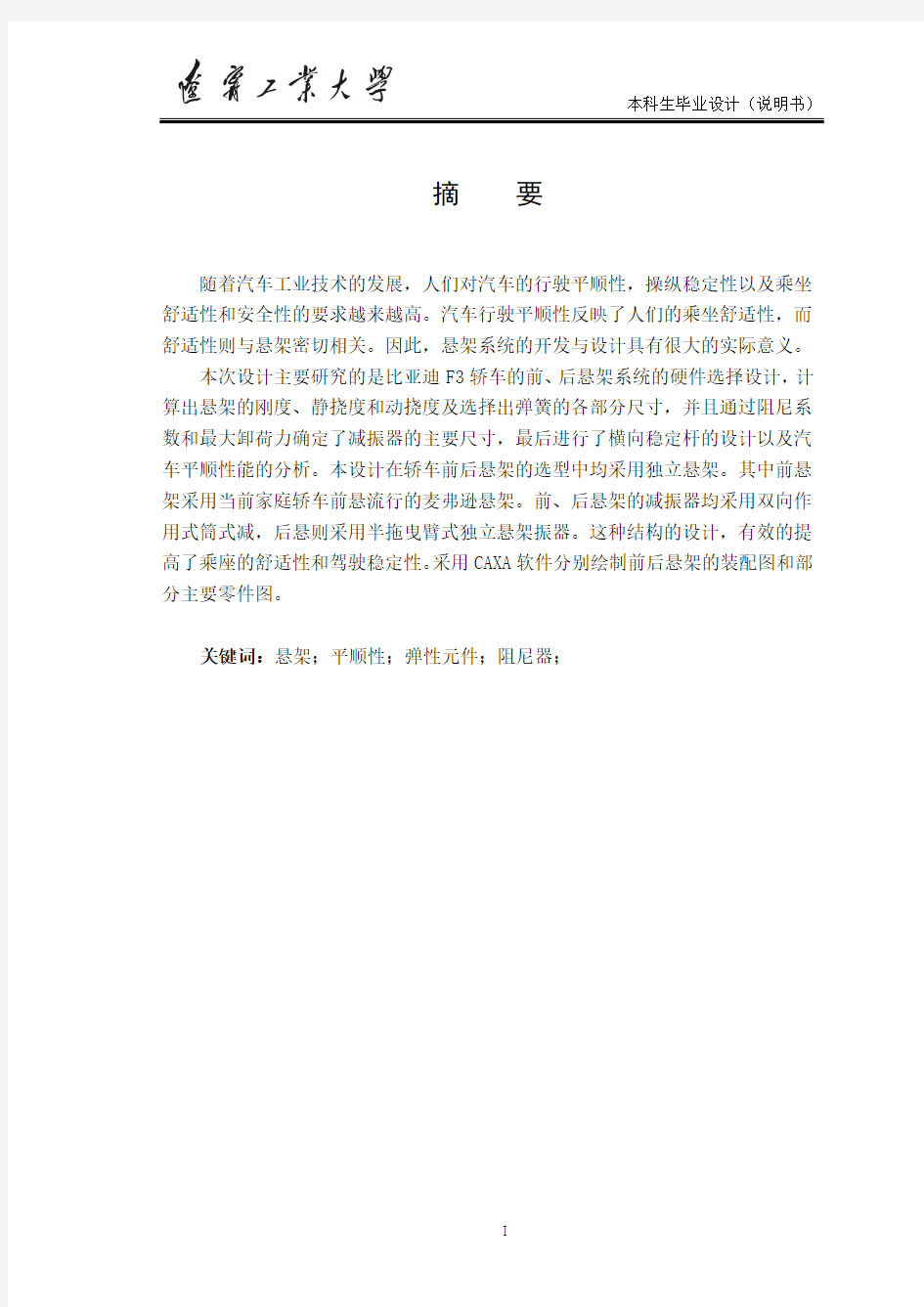比亚迪F3轿车悬架系统设计

- 1、下载文档前请自行甄别文档内容的完整性,平台不提供额外的编辑、内容补充、找答案等附加服务。
- 2、"仅部分预览"的文档,不可在线预览部分如存在完整性等问题,可反馈申请退款(可完整预览的文档不适用该条件!)。
- 3、如文档侵犯您的权益,请联系客服反馈,我们会尽快为您处理(人工客服工作时间:9:00-18:30)。
摘要
随着汽车工业技术的发展,人们对汽车的行驶平顺性,操纵稳定性以及乘坐舒适性和安全性的要求越来越高。汽车行驶平顺性反映了人们的乘坐舒适性,而舒适性则与悬架密切相关。因此,悬架系统的开发与设计具有很大的实际意义。
本次设计主要研究的是比亚迪F3轿车的前、后悬架系统的硬件选择设计,计算出悬架的刚度、静挠度和动挠度及选择出弹簧的各部分尺寸,并且通过阻尼系数和最大卸荷力确定了减振器的主要尺寸,最后进行了横向稳定杆的设计以及汽车平顺性能的分析。本设计在轿车前后悬架的选型中均采用独立悬架。其中前悬架采用当前家庭轿车前悬流行的麦弗逊悬架。前、后悬架的减振器均采用双向作用式筒式减,后悬则采用半拖曳臂式独立悬架振器。这种结构的设计,有效的提高了乘座的舒适性和驾驶稳定性。采用CAXA软件分别绘制前后悬架的装配图和部分主要零件图。
关键词:悬架;平顺性;弹性元件;阻尼器;
Abstract
With the development of the automobile industry of motor vehicles on ride comfort, handling and stability as well as comfort and safety of the increasingly demanding, Vehicle Ride also closely related with the suspension. Therefore, the design of the suspension system has a practical significance.
The main design of the study is BYD F3 car front and rear the suspension system of choice of hardware design, calculate the suspension stiffness, static and dynamic deflection deflection. By damping and unloading of the largest absorber identified the main dimensions. Finally, the design of the horizontal stabilizer. The design of the car before and after the suspension are used in the selection of independent suspension. Suspension of them adopted before the current family sedan before hanging popular McPherson suspension, was suspended after a drag arm suspension. Before and after the suspension of the shock absorber have adopted a two-way role-Shock Absorber. The design of this structure, effectively raising theof comfort and driving stability. By CAXA software were drawn before and after the suspension of the assembly and parts plans.
Key words: suspension; ride comfort; elastic element;buffer;
目录
摘要 ................................................................................................................... I Abstract .................................................................................................................... II 目录 ................................................................................................................ III 第1章绪论 . (1)
1.1悬架系统概述 (1)
1.2悬架的构成和类型 (3)
1.2.1构成 (3)
1.2.2类型 (3)
1.3课题研究的目的及意义 (4)
第2章前、后悬架结构的选择 (5)
2.1悬架的结构形式 (5)
2.2非独立悬架 (5)
2.3独立悬架 (6)
2.4 前后悬架方案的选择 (7)
2.5主要元件 (8)
2.5.1弹性元件 (8)
2.5.2减振器 (9)
2.6辅助元件 (9)
2.6.1横向稳定器 (9)
2.6.2缓冲块 (10)
第3章技术参数确定与计算 (11)
3.1悬架性能参数的选择 (11)
3.2悬架的自振频率 (11)
3.3侧倾角刚度 (12)
3.4悬架的动、静挠度选择 (12)
第4章弹性元件的设计计算 (14)
4.1前悬架弹簧 (14)
4.2后悬架弹簧 (15)
第5章悬架导向机构的设计 (17)
5.1导向机构设计要求 (17)
5.2麦弗逊独立悬架示意图 (17)
5.3导向机构受力分析 (18)
5.4横臂轴线布置方式 (20)
5.5导向机构的布置参数 (20)
5.5.1 侧倾中心 (20)
第6章减振器设计 (22)
6.1减振器的概述 (22)
6.2减振器的分类 (22)
6.3减振器参数选取 (23)
6.4减振器阻尼系数 (23)
6.5最大卸荷力 (24)
6.6筒式减振器主要尺寸 (24)
6.6.1筒式减振器工作直径 (24)
6.6.2油筒直径 (25)
第7章横向稳定杆的设计 (26)
第8章平顺性分析 (27)
8.1平顺性概念 (27)
8.2汽车的等效振动分析 (27)
8.3车身加速度的幅频特性 (28)
8.4相对动载的幅频特性 (29)
8.5悬架动挠度的幅频特性 (31)
8.5影响平顺性的因数 (32)
8.5.1结构参数对平顺性的影响 (32)
8.5.2使用因素对平顺性的影响 (33)
第9章总结 (34)
参考文献 (35)
致谢 (36)
附录Ⅰ (37)
Suspension Principle Of Work (37)
附录Ⅱ (48)
